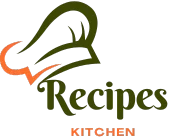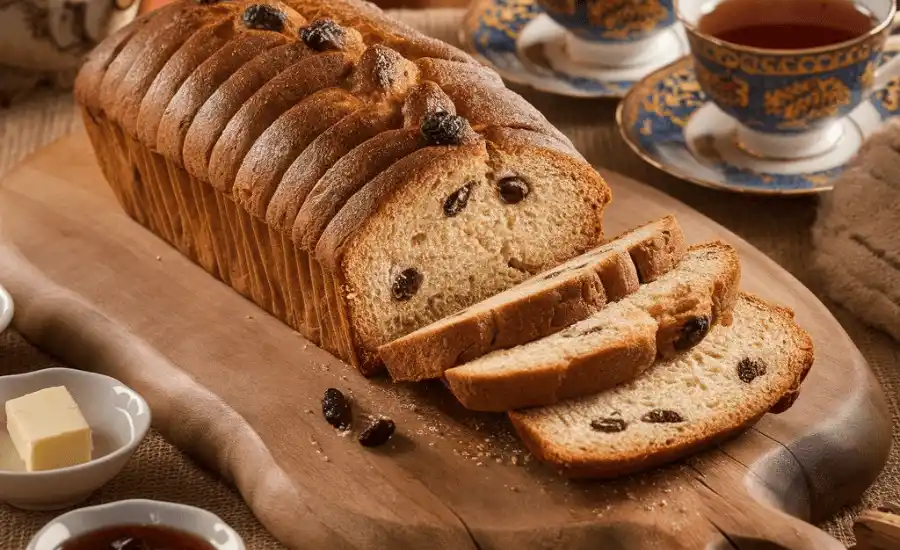There’s nothing quite like the warm, comforting aroma of freshly baked Reka bread wafting through your kitchen, instantly transporting you to cozy family gatherings or rustic Eastern European villages. This Reka bread recipe brings the magic of traditional Reka bread to your home with simple ingredients and easy-to-follow steps. Whether you’re a novice baker or a seasoned pro, this loaf’s golden crust and airy, slightly sweet crumb will steal your heart. Perfect for pairing with hearty soups, creamy cheeses, or just a generous smear of butter, Reka bread is a versatile addition to any meal.
In this guide, we’ll walk you through every step of making homemade Reka bread, from activating the yeast to achieving that perfect crust. You’ll also find answers to common questions like “What flour is best for Reka bread?” and “How do I keep it fresh?” With tips for gluten-free options and creative add-ins, this traditional Reka bread recipe is designed to delight your taste buds and impress your loved ones. Let’s dive into the joy of baking and create a loaf that’s as beautiful as it is delicious!
Table of Contents
Why You’ll Love This Recipe
Making this Reka bread recipe fills your kitchen with warmth and comfort, like a cozy embrace. Here’s why you’ll fall in love with this traditional Reka bread:
- Simple Ingredients: With pantry staples like flour, yeast, and a touch of sugar, this recipe is accessible for beginners and budget-friendly.
- Authentic Taste: Its fluffy texture and delicate sweetness reflect classic Eastern European traditions, delivering a bite that feels both nostalgic and deeply satisfying.
- Versatile Delight: Enjoy it fresh with butter, as a side for soups, or toasted for sandwiches. Reka bread shines in any setting.
- Customizable Fun: Add rosemary, raisins, or nuts to make it your own, perfect for experimenting in the kitchen.
- Joy of Baking: There’s something magical about kneading dough and watching it rise, filling your home with that irresistible bread aroma.
This homemade Reka bread is more than a recipe, it’s a chance to create memories with loved ones. Whether you’re baking for a cozy dinner or a special occasion, this loaf will leave everyone asking for seconds.
Ingredients
Creating a perfect loaf of Reka bread starts with simple, high-quality ingredients. This Reka bread recipe uses pantry staples to deliver that authentic, airy texture and golden crust you’ll love. Below, we’ve listed everything you need, along with why each ingredient matters and substitutions to suit your preferences.
Ingredients List (Makes 1 Loaf)
- 2 cups bread flour (high-protein, 12–13% protein content) – Provides structure for a chewy, well-risen loaf.
- 1 teaspoon active dry yeast – The magic behind the bread’s rise, creating that light, airy crumb.
- 1 teaspoon salt – Enhances flavor and controls yeast activity for balanced dough.
- 1 tablespoon sugar – Feeds the yeast and adds a subtle sweetness to the bread.
- Add 1 cup of warm water (105–115°F) to activate the yeast and hydrate the dough.
- 2 tablespoons olive oil or melted butter – Adds richness and a soft texture.
- 1 large egg (optional) – Enriches the dough for a tender crumb and golden color.
- Optional add-ins: 1/4 cup raisins, chopped nuts, or herbs like rosemary for a personalized twist.
Why These Ingredients Work
Bread flour is the star of this traditional Reka bread recipe, offering the gluten strength needed for a lofty rise. If you’re wondering about the best flour for Reka bread, stick with high-protein bread flour for optimal texture, though all-purpose flour can work in a pinch (expect a slightly denser loaf). The yeast and warm water team up to create those airy pockets, while sugar gives the bread its signature hint of sweetness. Olive oil or butter keeps the crumb soft, and the optional egg adds a luxurious touch. Add-ins like raisins or rosemary let you customize your loaf for extra flair.
Substitutions
- Gluten-Free: Swap bread flour for a 1:1 gluten-free baking blend, but add 1/2 tsp xanthan gum if not included in the mix.
- Vegan: Skip the egg and use a flax egg (1 tbsp ground flaxseed + 3 tbsp water).
- Oil Alternatives: Substitute olive oil with avocado oil or melted coconut oil for a different flavor profile.
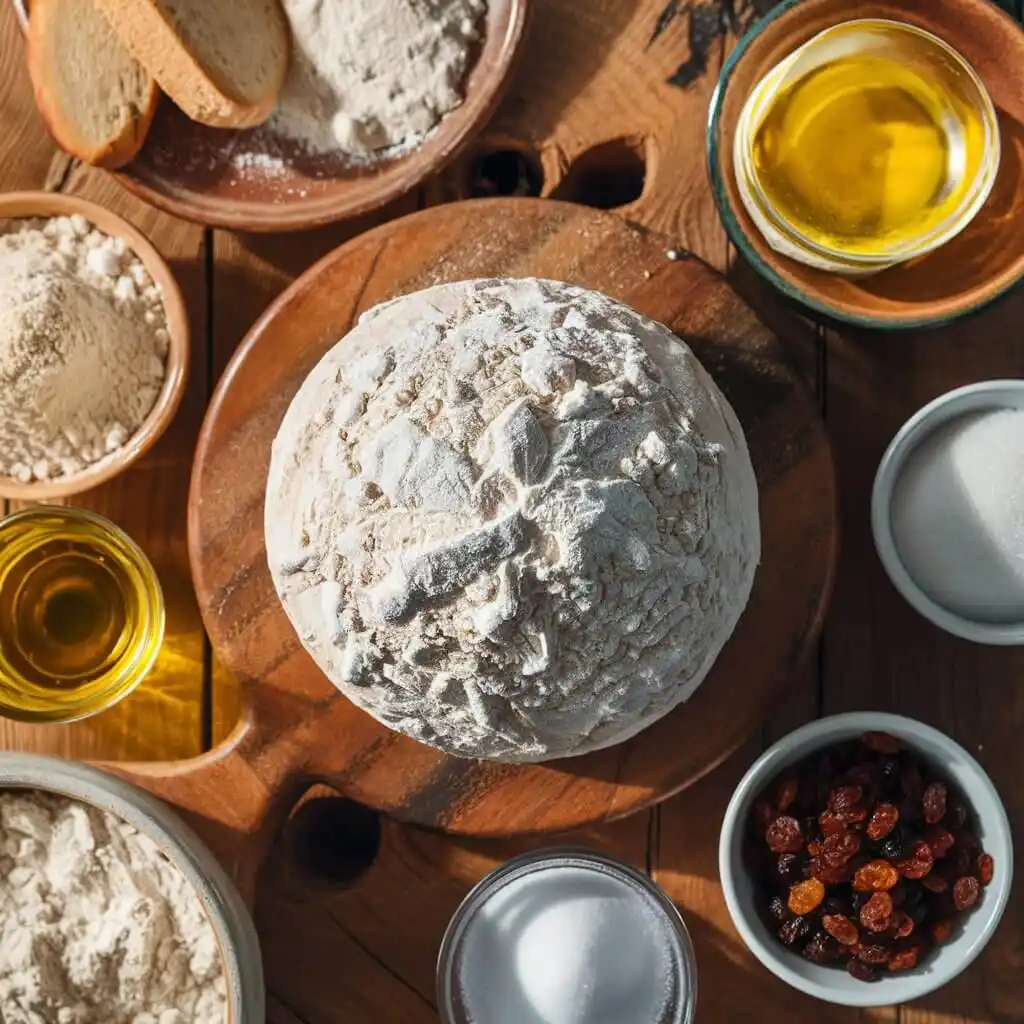
Step-by-Step Instructions
Baking this Reka bread recipe is a rewarding journey that transforms simple ingredients into a golden, airy loaf. Follow these clear, beginner-friendly steps to create a traditional Reka bread that’s perfect for any occasion. With expert tips and troubleshooting advice, you’ll be slicing into a warm, homemade loaf in no time!
Instructions
- Activate the Yeast (5–10 minutes): In a small bowl, combine 1 cup of warm water (105–115°F) with 1 teaspoon active dry yeast and a pinch of the 1 tablespoon sugar. Gently stir the mixture and allow it to sit for 5 to 10 minutes, or until it becomes foamy on top. Tip: If it doesn’t foam, your yeast may be expired, use fresh yeast to ensure a good rise.
- Mix the Dough (5 minutes): In a large mixing bowl, whisk together 2 cups bread flour, the remaining sugar, and 1 teaspoon salt. Create a well in the center and pour in the yeast mixture, 2 tablespoons olive oil (or melted butter), and 1 large egg (if using). Mix with a wooden spoon or a spatula until the dough develops a rough, shaggy consistency. Tip: Avoid adding extra flour at this stage to keep the dough light.
- Knead the Dough (7–10 minutes): Turn the dough onto a lightly floured surface. Knead by hand for 7–10 minutes (or 5–7 minutes with a stand mixer fitted with a dough hook) until the dough is smooth, elastic, and slightly tacky. If using add-ins like 1/4 cup raisins or herbs, gently knead them in during the last 2 minutes. Troubleshooting: If the dough feels too sticky, sprinkle flour sparingly, over-flouring can make the bread dense.
- First Rise (1–2 hours): Place the dough in a lightly greased bowl, turning it to coat all sides. Cover with a clean kitchen towel or plastic wrap and let it rise in a warm spot (75–80°F) for 1–2 hours, until doubled in size. Tip: If your kitchen is cool, place the bowl in a turned-off oven with the light on or near a warm stovetop.
- Shape the Dough (5 minutes): Gently punch down the dough to release air. Transfer it to a lightly floured surface and shape it into a round or oval loaf, depending on your preference. Place it on a parchment-lined baking sheet or in a greased 9×5-inch loaf pan. Tip: For a rustic look, score the top with a sharp knife before the second rise.
- Second Rise (30–45 minutes): Cover the shaped dough with a towel and let it rise again for 30–45 minutes, until puffy but not doubled. Troubleshooting: If the dough over-rises, it may collapse during baking, check it early in cooler climates.
- Preheat the oven to 375°F (190°C) (10 minutes): For a crisp, bakery-style crust, place a shallow dish of boiling water on the bottom rack to generate steam. Tip: Brushing the dough with water or olive oil before baking enhances the crust’s shine.
- Bake the Bread (25–30 minutes): Slash the top of the dough with a sharp knife or razor blade to allow even expansion. Bake for 25–30 minutes, until the crust is golden brown and the internal temperature reaches 190°F. The loaf should sound hollow when tapped. Troubleshooting: If the crust browns too quickly, tent with foil after 20 minutes.
- Cooling and Slicing (30 minutes): Place the freshly baked loaf on a wire rack and leave it undisturbed for a minimum of 30 minutes to cool before cutting. This prevents a gummy texture and lets the flavors settle. Tip: For perfect slices, use a serrated bread knife.
Expert Tips
- Check Yeast Freshness: Always proof yeast to avoid a flat loaf.
- Room Temperature Matters: A warm environment speeds up rising; too cold, and it slows down.
- Steam for Crust: The water pan mimics a professional oven for a crisp, golden crust.
Troubleshooting
- Dense Bread? Make sure your yeast is fresh and avoid over-kneading, as it can collapse the air pockets in the dough.
- Uneven Rise? Ensure even dough shaping and consistent oven temperature.
- Crust Too Soft? Increase steam or bake a few minutes longer.
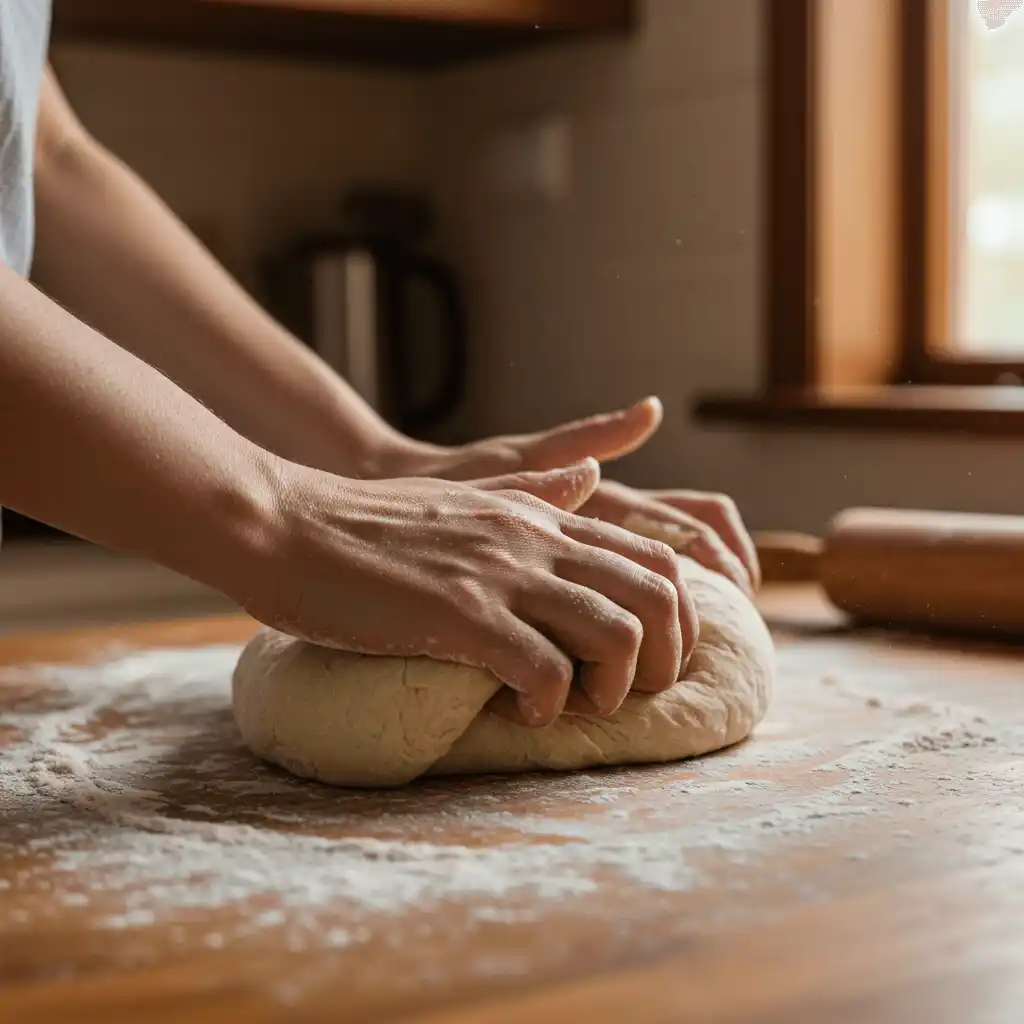
Tips and Variations
Mastering this Reka bread recipe is all about making it your own while ensuring perfect results every time. These tips and variations will help you customize your traditional Reka bread, adapt it to dietary needs, and streamline the process. Whether you’re aiming for a gluten-free loaf or a flavor-packed twist, we’ve got you covered with expert advice to elevate your baking game.
Expert Tips for Perfect Reka Bread
- Test Your Yeast: Always proof your yeast in warm water to ensure it’s active. No foam? Start with fresh yeast to avoid a dense loaf.
- Measure Flour Accurately: Use the spoon-and-level method to avoid packing in too much flour, which can make the bread heavy.
- Create a Warm Rising Spot: If your kitchen is chilly, place the dough in a turned-off oven with the light on or near a warm stovetop to speed up rising.
- Steam for a Crisp Crust: Place a pan of boiling water in the oven during baking to mimic a professional bakery’s crusty finish.
Flavor Variations
- Herby variation: Mix in 1 tablespoon of chopped rosemary, thyme, or dill during kneading, ideal for serving with soups.
- Sweet and Fruity: Mix in 1/4 cup raisins or dried cranberries for a touch of sweetness, ideal for breakfast or tea time.
- Nutty Crunch: Fold in 1/4 cup chopped walnuts or sesame seeds for texture and flavor. Toast nuts lightly for deeper taste.
- Savory Garlic Bread: Incorporate 1–2 teaspoons roasted garlic into the dough for a bold, savory twist.
Dietary Swaps
- Gluten-Free Reka Bread: Swap bread flour for a 1:1 gluten-free baking blend and add 1/2 teaspoon xanthan gum (if not included in the mix) for structure. Note: Gluten-free dough may require slightly less water, adjust as needed.
- Vegan Option: Use 1 tbsp flaxseed + 3 tbsp water, rested 5 mins, instead of an egg and let it sit for 5 minutes, for a plant-based loaf.
- Low-Sugar: Reduce sugar to 1/2 teaspoon or use a natural sweetener like honey for a healthier twist.
Time-Saving Ideas
- Use a Stand Mixer: Cut kneading time to 5–7 minutes with a dough hook.
- Make Ahead: Prepare the dough the night before, let it rise slowly in the fridge, and shape it the next day.
Storage
Keeping your Reka bread fresh ensures you can enjoy its delightful texture and flavor for days, or even months! Proper storage is key to maintaining the quality of this traditional Reka bread recipe. Here’s how to store your homemade loaf to savor every slice.
- Room Temperature (Up to 3 Days): Once cooled completely, wrap the bread in a clean kitchen towel or place it in an airtight container or bread box. This prevents moisture buildup while keeping the crust crisp. Storage: Keep the loaf in a dry, shaded spot with good airflow, away from heat and sunlight. Tip: Avoid plastic bags, as they can soften the crust.
- Refrigeration (Up to 1 Week): If you need to store it longer, wrap the loaf tightly in plastic wrap and place it in the fridge. Note that refrigeration may slightly dry out the bread, so toast slices for the best texture.
- Freezing (Up to 3 Months): For long-term storage, slice the bread and wrap individual slices or the whole loaf in plastic wrap, then aluminum foil. Place in a freezer-safe bag. To serve, thaw at room temperature or toast straight from the freezer. Tip: Write the date on the packaging to help monitor freshness.
How to Serve
Freshly baked Reka bread is a versatile star that elevates any meal with its golden crust and soft, airy crumb. This traditional Reka bread recipe works beautifully in a variety of settings, from casual breakfasts to elegant dinners. Here are some delightful ways to serve your homemade loaf, along with presentation tips to make every slice picture-perfect.
Serving Suggestions
- With Soups and Stews: Pair thick slices with hearty dishes like tomato soup, lentil stew, or borscht for a comforting Eastern European-inspired meal.
- Bruschetta Bliss: Toast slices, rub with garlic, and top with diced tomatoes, fresh basil, and a drizzle of olive oil for a vibrant appetizer.
- Cheese Board Companion: Serve thin slices alongside aged cheddar, brie, or gouda for a crowd-pleasing starter at gatherings.
- Breakfast Treat: Slather warm slices with butter and jam or use as a base for avocado toast with a sprinkle of sea salt.
- Croutons or Sandwiches: Cube stale bread for crunchy salad croutons or use thick slices for hearty sandwiches filled with roasted veggies or meats.
Presentation Tips
- Slicing: For best results, slice the bread with a serrated knife to achieve even, tidy cuts. For rustic appeal, tear chunks by hand.
- Plating: Arrange slices on a wooden board with small bowls of olive oil, herbs, or spreads for dipping.
- Garnish: Sprinkle fresh herbs like rosemary or thyme over the loaf for a pop of color.
Serving homemade Reka bread is all about creating warm, inviting moments. Whether it’s a cozy family dinner or a festive gathering, this loaf will steal the show.
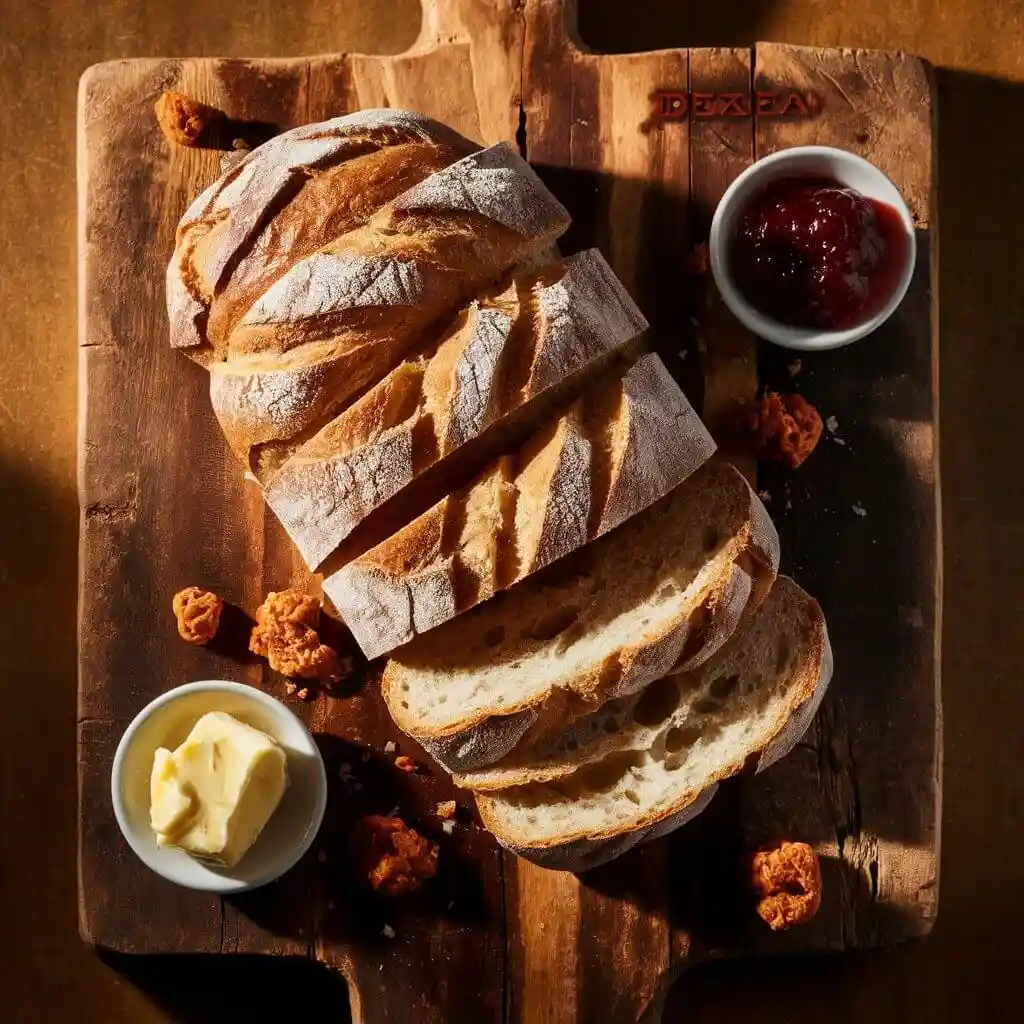
Nutritional Breakdown
Understanding the nutritional profile of your Reka bread helps you enjoy this traditional Reka bread recipe as part of a balanced diet. Below is an estimated nutritional breakdown per serving, based on a loaf yielding 12 slices. Note that values may vary slightly depending on ingredient choices or add-ins.
Nutritional Information (Per Slice, ~1/12 of loaf)
- Calories: ~150 kcal
- Protein: ~4g (supports muscle health, thanks to high-protein bread flour)
- Carbohydrates: ~25g (provides energy, primarily from flour and sugar)
- Fat: ~3g (from olive oil or butter, adding richness)
- Fiber: ~1g (slightly higher with whole wheat flour or nut add-ins)
- Sugar: ~1g (sourced from added sugars and natural starches)
- Sodium: ~200mg (from salt, enhancing flavor)
Variations to Note
- Add-Ins: Including 1/4 cup raisins or nuts may increase calories (~10–20 kcal per slice) and fat content.
- Gluten-Free: Using gluten-free flour blends may alter carbohydrate and fiber content slightly.
- Vegan: Swapping the egg for a flax egg maintains similar nutrition but adds a touch of fiber.
This homemade Reka bread is a wholesome choice for breakfast or sides.
FAQs
Baking a Reka bread recipe can spark a few questions, especially if you’re new to bread-making or want to perfect your loaf. Below, we’ve answered 10 common questions inspired by Google’s “People Also Ask” and tailored to this traditional Reka bread recipe. These answers address everything from technique to storage, ensuring you have all the info you need for success.
1. How do I make Reka bread from scratch?
To make homemade Reka bread, start by activating 1 teaspoon yeast in 1 cup warm water (105–115°F) with a pinch of sugar. Mix with 2 cups bread flour, 1 teaspoon salt, 1 tablespoon sugar, 2 tablespoons olive oil, and an optional egg. Knead for 7–10 minutes, let the dough rise until doubled (1–2 hours), shape into a loaf, and rise again for 30–45 minutes. Bake in a preheated oven at 375°F for 25 to 30 minutes, or until the top is golden brown. Use fresh ingredients and don’t rush the rising process for the best results.
2. What flour is best for making Reka bread?
High-protein bread flour (12–13% protein) is ideal for this Reka bread recipe, as it creates a strong gluten structure for a light, chewy loaf. All-purpose flour works but may yield a denser texture. For a nuttier flavor, substitute up to 25% with whole wheat flour, but avoid using too much to prevent a heavy loaf. Source quality flour from local mills for superior results.
3. How can I maintain the freshness of Reka bread?
To keep your traditional Reka bread fresh, cool it completely, then store it in an airtight container or wrapped in a clean towel at room temperature for up to 3 days. To store for longer, wrap the bread tightly in plastic and refrigerate for up to one week, or freeze individual slices in a freezer-safe bag for up to three months. Thaw at room temperature or toast directly from frozen to enjoy.
4. Can I make Reka bread gluten-free?
Yes! Swap bread flour for a 1:1 gluten-free baking blend and add 1/2 teaspoon xanthan gum (if not included in the mix) for structure. You may need to slightly modify the water quantity, as gluten-free flours absorb liquid differently. The texture may be slightly denser, but it’s a great option for those avoiding gluten.
5. How long does it take to make Reka bread?
The entire process takes approximately 2.5 to 3 hours, including 15 minutes of preparation, 1 to 2 hours for the first rise, 30 to 45 minutes for the second rise, and 25 to 30 minutes for baking. Cooling takes an additional 30 minutes. Plan ahead to allow for rising time, which is key to an airy loaf.
6. What can I serve with Reka bread?
Reka bread pairs beautifully with soups like borscht or lentil, toasted as bruschetta with tomatoes and basil, or sliced for sandwiches. Serve with cheeses like brie or cheddar for a snack board, or spread with butter and jam for breakfast. Its versatility makes it a star at any meal.
7. Can I freeze Reka bread dough?
Yes, You can freeze the dough after it has completed the initial rise. Punch it down, wrap tightly in plastic wrap and a freezer bag, and freeze for up to 2 months. Let the dough thaw overnight in the refrigerator, then shape it and continue with the second rise and baking steps. This is a great time-saver!
8. Why is my Reka bread dense?
Dense bread often results from expired yeast, over-kneading, or adding too much flour. Always proof yeast to check it’s active, knead just until smooth (7–10 minutes), and measure flour with the spoon-and-level method. A cool rising environment can also slow the rise, use a warm spot (75–80°F).
9. Is it possible to use a bread machine for this recipe?
While this traditional Reka bread recipe is designed for hand-kneading, you can adapt it for a bread machine. Add ingredients in the order recommended by your machine (typically wet first, then dry, yeast last). Choose the dough setting, then form the dough and bake it in the oven to achieve a crisp, golden crust.
10. What makes Reka bread different from other breads?
Reka bread stands out for its Eastern European roots, with a slightly sweet, airy crumb and crisp crust. Unlike denser rye breads or tangy sourdoughs, it’s light and versatile, with a subtle sweetness from sugar and optional egg, making it perfect for both savory and sweet pairings.
Conclusion
Baking this Reka bread recipe is more than just a kitchen project, it’s a heartfelt way to bring the warmth and tradition of Eastern European baking into your home. With its golden crust, airy crumb, and subtle sweetness, this traditional Reka bread is sure to become a family favorite. Whether you’re slicing it for a cozy soup night or toasting it for breakfast, every bite carries the joy of homemade goodness. The best part? This Reka bread recipe is easy enough for beginners yet versatile enough to impress seasoned bakers with creative add-ins like rosemary or raisins.
Now, it’s your turn to give this Reka bread recipe a try. Roll up your sleeves and fill your kitchen with the irresistible aroma of freshly baked bread. Share your creations with friends and family. Happy baking, and enjoy every delicious moment!
